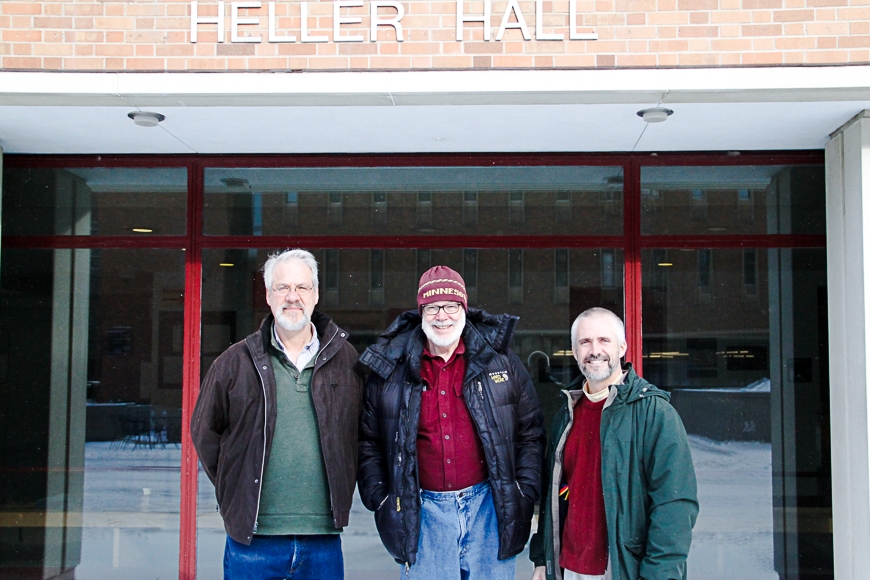Many Disciplines, One Cause: The Push for Better Science
Left to right: Niels Waller, Charles Geyer, Alan Love. Photo by Phuong Tran, CLAgency student.
Professor Charles Geyer understands the importance of collecting data for research. “Without statistics, you don’t have results,” Geyer explains. But what happens when research isn’t conducted appropriately? “It’s like playing tennis without a net,” he says. “You always win.”
This idea is what originally interested Geyer in the efforts of the open science movement. He has been a supporter of scientific methods that avoid questionable research practices for many years, but recently found a community of other professors at the U—among them Alan Love of the Minnesota Center for Philosophy of Science and Niels Waller of the Department of Psychology—who are strong supporters of methods that yield reproducible results in scientific inquiry. They are collaborating to create a culture that fosters these practices among the students they mentor.
So, What is the Open Science Movement?
Open science is a movement that has been growing alongside the digital age. The goal for research published in science journals is that authors make their data and methodology explicit. However, scientific papers never include everything due to space constraints.
Now with most scientific journals publishing online, researchers across the world have easier access to data sets and methods (e.g., as supplementary information) that were previously difficult to acquire. As Alan Love, professor of philosophy, describes it, “In general, [advocates of open science] are trying to make what is in science more transparent.”
“There are two main issues that open science is trying to counter,” explains Geyer, “publication bias and multiple testing without correction.” Publication bias is the idea that research is only published based on the outcome of the study. When researchers know that a particular academic journal only publishes data that supports a specific hypothesis, they are forced to either conform to this expectation or risk being rejected. Multiple testing without correction, on the other hand, is when the authors of a paper run the same test on many subjects, but only cherry-pick and report the data they like. Geyer explains that this practice occurs all the time, and some researchers still don’t consider these research tactics questionable even though they violate the norms of statistical methodology.
The hope is that the implementation of the ideals of the open science movement, such as can be seen in the Open Science Framework, will help to eliminate questionable research practices and encourage better science. “Open science should just be science,” says Geyer. It is too bad that we have gotten to the place where research needs to be questioned, but “science should be out in the open. There are no secrets, there is nothing up your sleeve, anyone can comment. There’s no authorities, no votes, just open literature arguing back and forth about something,” he adds.
A Cross-Disciplinary Collaboration
While the term “open science” is fairly new, these ideas and others related to increasing reproducibility in the sciences have had a following for quite some time. Niels Waller, a psychology professor at the University, became interested in the movement over 20 years ago.
Although some believe that issues of reproducibility are more prevalent in the social sciences, Waller disagrees. “Over the past three decades, I have collaborated with colleagues in psychology, medicine, chemistry, dentistry, and neuroscience. These collaborations have convinced me that the issues relevant to reproducibility in the social sciences are relevant to all research activities regardless of discipline.” The misconception that tainted research only occurs in specific fields is one that Geyer, Love, and Waller are trying to combat. “We don’t really need an open science movement at the University of Minnesota. We need it in each discipline,” explains Geyer.
Their interest in the many dimensions of reproducibility has led to some important discussions about how to conduct research effectively and responsibly at the University. This past fall, the professors engaged in bi-weekly discussions with other faculty, graduate students, and postdoctoral scholars about reproducibility and measurement. “Our aim was to create a culture of active reflection on research practices across diverse sciences to improve scientific inquiry across disciplines,” says Love.
The Future of Reproducible Science
Although the future is difficult to predict, all three professors agree that the outlook for a world guided by the ideals of the open science movement is promising. As Geyer explains, “almost every journal is now requiring most papers to publish the data.” This is a huge step for academic journals, one that is necessary to promote transparency.
Processes at the University of Minnesota are changing as well. As a teacher, Waller can properly train students in research practices conducive to reproducibility. “Last spring I taught a course in the psychology department about the mechanics of literate programming, reproducible research, and computer programming,” says Waller. He hopes to continue teaching the course in the future.
As for the critics of the open science movement, Geyer isn’t concerned. “Sure, open science does make science somewhat more confrontational, although it always was supposed to be. That’s the only way to get at the truth.”
This story was written by an undergraduate student in CLA.



